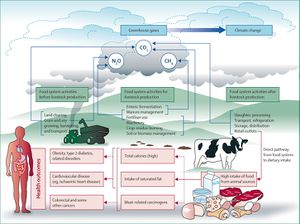Food and agriculture related climate and health impacts: Difference between revisions
Jump to navigation
Jump to search
No edit summary |
No edit summary |
||
| Line 2: | Line 2: | ||
{{assessment|moderator= Miranda Loh}} | {{assessment|moderator= Miranda Loh}} | ||
Based on the assessment done in Friel S et al. 2009. Public health benefits of strategies to reduce greenhouse gas emissions: food and agriculture. Lancet. [http://www.thelancet.com/journals/lancet/article/PIIS0140-6736(09)61753-0/fulltext] | Based on the assessment done in Friel S et al. 2009. Public health benefits of strategies to reduce greenhouse gas emissions: food and agriculture. Health and Climate Series 4, The Lancet. [http://www.thelancet.com/journals/lancet/article/PIIS0140-6736(09)61753-0/fulltext] | ||
==Scope== | ==Scope== | ||
| Line 47: | Line 47: | ||
[[Image:Fried lancet2009 foodagri diagram.jpg|thumb |alt=diagram from Lancet article |Figure 2:Processes in the food and agriculture system that lead to greenhouse-gas emissions and population health outcomes Dotted lines indicate health outcomes that were not modelled in this study. CO2=carbon dioxide. N2O=nitrous oxide. CH4=methane.]] | [[Image:Fried lancet2009 foodagri diagram.jpg|thumb |alt=diagram from Lancet article |Figure 2:Processes in the food and agriculture system that lead to greenhouse-gas emissions and population health outcomes Dotted lines indicate health outcomes that were not modelled in this study. CO2=carbon dioxide. N2O=nitrous oxide. CH4=methane.]] | ||
===Decision variables=== | ===Decision variables=== | ||
Revision as of 13:44, 27 November 2009
[[Category: ]]
| Moderator:Miranda Loh (see all) |
|
|
| Upload data
|
Based on the assessment done in Friel S et al. 2009. Public health benefits of strategies to reduce greenhouse gas emissions: food and agriculture. Health and Climate Series 4, The Lancet. [1]
Scope
Purpose
Describe strategies that would allow the food and agricultural sector to meet the targets recommended by the UK Committee on Climate change and quantify these strategies' main effects on health.
Boundaries
Spatial:
- UK
- Sao Paulo, Brazil
Temporal:
- Baseline = 2010
- Future projection = 2030
Population: Adult
Policy strategies:
- Improve efficiency of livestock farming
- Increase carbon capture through management of land use
- Improve manure management
- Decrease dependence on fossil fuel inputs
Scenarios
* Scenarios define particular conditions that are of interest irrespective whether they describe
reality or not (e.g. what-if scenarios).
Intended users
* Intended users are those for whom the assessment is made.
Participants
* Participants are those who may participate in the making of the assessment.
The minimum group of people for a successful assessment is always described.
If some groups must be excluded, this must be explicitly motivated.
Definition

Decision variables
- UK technological change to reduce emissions in agriculture
- UK technological change and reduced livestock production
- Reduction in dietary intake of saturated fat and cholesterol from animal sources
Indicators
- Health outcomes from:
- Dietary intake of saturated fate (DALYs, YLL, premature deaths)
- Serum cholesterol concentrations (YLL, premature deaths)
- Agricuture sector greenhouse gas emissions
Value variables
* Value variables: value judgements (usually about indicators).
Other variables
- Animal source saturated fat intake
- Dietary chlesterol intake
- Serum cholesterol concentrations
- Livestock production
- Hazard ratio for dietary intake of saturated fat and disability from ischaemic heart disease > 35 years age
- Hazard ratio for dietary intake of saturated fat and death from ischaemic heart disease > 35 years age
- Hazard ratio for serum cholesterol concentration and death from ischaemic heart disease
- Stroke burden of diesease
Analyses
Comparative risk assessment
Indices
- Age and gender UK
- Age and gender Sao Paulo
Result
Results
Conclusions
* Conclusions are based on the results, given the scope.